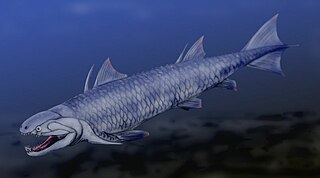
Acanthodii or acanthodians is an extinct class of gnathostomes. They are currently considered to represent a paraphyletic grade of various fish lineages basal to extant Chondrichthyes, which includes living sharks, rays, and chimaeras. Acanthodians possess a mosaic of features shared with both osteichthyans and chondrichthyans. In general body shape, they were similar to modern sharks, but their epidermis was covered with tiny rhomboid platelets like the scales of holosteians.

Psarolepis is a genus of extinct bony fish which lived around 397 to 418 million years ago. Fossils of Psarolepis have been found mainly in South China and described by paleontologist Xiaobo Yu in 1998. It is not known certainly in which group Psarolepis belongs, but paleontologists agree that it probably is a basal genus and seems to be close to the common ancestor of lobe-finned and ray-finned fishes. In 2001, paleontologist John A. Long compared Psarolepis with onychodontiform fishes and refer to their relationships.
Luckeus is an extinct genus of prehistoric lobe-finned fish. Luckeus belonged to the order Onychodontida. It lived during the Early Devonian to Middle Devonian period in what os now central Australia.
Andreolepis is an extinct genus of prehistoric fish, which lived around 420 million years ago. It was described by Walter Gross in 1968 based on scales found in the Hemse Formation in Gotland, Sweden. It is placed in the monogeneric family Andreolepididae and is generally regarded as a primitive member of the class Actinopterygii based on its ganoid scale structure; however some new research regards it as a stem group of osteichthyans.

Osteolepididae is a family of primitive, fish-like tetrapodomorphs that lived during the Devonian period. The family is generally thought to be paraphyletic, with the traits that characterise the family being widely distributed among basal tetrapodomorphs and other osteichthyans. Some of genera historically placed in Osteolepididae have more recently been assigned to the family Megalichthyidae, which appears to be a monophyletic group.
Amadeodipterus is an extinct genus of lungfish which lived during the Devonian period. Fossils have been found in Central Australia.
Achoania is an extinct genus of primitive bony fish which lived during the Early Devonian period. It is known from a skull discovered in the Xitun Formation of Yunnan, China. While originally originally considered to be a lobe-finned fish, later studies suggested that it may be a stem-group Osteichthyes instead.
Guiyu oneiros is one of the earliest articulated bony fish discovered. Fossils of Guiyu have been found in what is now Qujing, Yunnan, China, in late Silurian marine strata, about 425 million years old.
Scanilepis is an extinct genus of prehistoric bony fish that lived during the Rhaetian-?Hettangian ages. The type species, S. dubia, is known from the Rhaetian freshwater deposits of the Bjuv member of the Höganäs Formation, southwestern Sweden. A second species, S. spitzbergensis was mentioned from the Hettangian of the Festning section of the Grøfjorden area in Spitsbergen, Norway but was never described.
Ganopristodus is an extinct genus of prehistoric sarcopterygian or lobe-finned fish from the Devonian.
Iowadipterus is an extinct genus of prehistoric sarcopterygian or lobe-finned fish.
Muranjilepis is an extinct genus of prehistoric sarcopterygians or lobe-finned fish.
Cycloptychius is an extinct genus of prehistoric bony fish that existed in the Late Devonian epoch and the Carboniferous period in what is now France, Russia and the United Kingdom.
Dialipina is an extinct genus of prehistoric, marine osteichthyan. It was initially thought to be an early, basal actinopterygian, but recent phylogenetic analyses suggest that it may instead be a stem-osteichthyan.

Rhadinichthys is an extinct genus of prehistoric bony fish. It is known from several species that lived in the Late Devonian epoch, the Carboniferous period and the Cisuralian epoch in what is now Europe, South Africa, and North and South America. Some isolated scales from the Cisuralian of Europe were also referred to this genus.

The skull roof, or the roofing bones of the skull, are a set of bones covering the brain, eyes and nostrils in bony fishes and all land-living vertebrates. The bones are derived from dermal bone and are part of the dermatocranium.
Cosmine is a spongy, bony material that makes up the dentine-like layers in the scales of the lobe-finned fishes of the class Sarcopterygii. Fish scales that include layers of cosmine are known as cosmoid scales.
Janusiscus schultzei is an extinct gnathostome vertebrate dating from the Early Devonian period in Siberia, approximately 415 million years ago. It may be the sister group of the last common ancestor of Chondrichthyes or Osteichthyes. This makes J. schultzei a sister species to all living jawed vertebrates. The species name is in honor of Hans-Peter Schultze; the genus named after Janus, the Roman god of duality.







